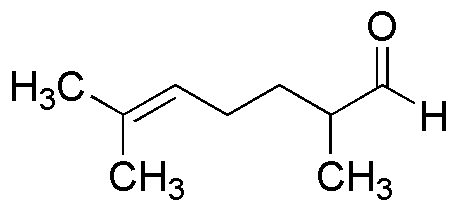2,6-Dimethyl-5-heptenal, a mixture of isomers, is widely utilized in research focused on:
- Flavor and Fragrance Industry: This compound is used as a flavoring agent in food products and as a fragrance in cosmetics due to its pleasant aroma, enhancing sensory experiences.
- Perfume Formulation: Its unique scent profile makes it a valuable ingredient in perfume formulations, providing depth and complexity to fragrances.
- Chemical Synthesis: It serves as a versatile intermediate in organic synthesis, allowing chemists to create various compounds for pharmaceuticals and agrochemicals.
- Research Applications: In academic and industrial research, it is studied for its potential biological activities, contributing to the discovery of new therapeutic agents.
- Food Preservation: Due to its antimicrobial properties, it can be explored as a natural preservative in food products, offering a safer alternative to synthetic preservatives.
General Information
Properties
Safety and Regulations
Applications
2,6-Dimethyl-5-heptenal, a mixture of isomers, is widely utilized in research focused on:
- Flavor and Fragrance Industry: This compound is used as a flavoring agent in food products and as a fragrance in cosmetics due to its pleasant aroma, enhancing sensory experiences.
- Perfume Formulation: Its unique scent profile makes it a valuable ingredient in perfume formulations, providing depth and complexity to fragrances.
- Chemical Synthesis: It serves as a versatile intermediate in organic synthesis, allowing chemists to create various compounds for pharmaceuticals and agrochemicals.
- Research Applications: In academic and industrial research, it is studied for its potential biological activities, contributing to the discovery of new therapeutic agents.
- Food Preservation: Due to its antimicrobial properties, it can be explored as a natural preservative in food products, offering a safer alternative to synthetic preservatives.
Documents
Safety Data Sheets (SDS)
The SDS provides comprehensive safety information on handling, storage, and disposal of the product.
Product Specification (PS)
The PS provides a comprehensive breakdown of the product’s properties, including chemical composition, physical state, purity, and storage requirements. It also details acceptable quality ranges and the product's intended applications.
Certificates of Analysis (COA)
Search for Certificates of Analysis (COA) by entering the products Lot Number. Lot and Batch Numbers can be found on a product’s label following the words ‘Lot’ or ‘Batch’.
*Catalog Number
*Lot Number
Certificates Of Origin (COO)
This COO confirms the country where the product was manufactured, and also details the materials and components used in it and whether it is derived from natural, synthetic, or other specific sources. This certificate may be required for customs, trade, and regulatory compliance.
*Catalog Number
*Lot Number
Safety Data Sheets (SDS)
The SDS provides comprehensive safety information on handling, storage, and disposal of the product.
DownloadProduct Specification (PS)
The PS provides a comprehensive breakdown of the product’s properties, including chemical composition, physical state, purity, and storage requirements. It also details acceptable quality ranges and the product's intended applications.
DownloadCertificates of Analysis (COA)
Search for Certificates of Analysis (COA) by entering the products Lot Number. Lot and Batch Numbers can be found on a product’s label following the words ‘Lot’ or ‘Batch’.
*Catalog Number
*Lot Number
Certificates Of Origin (COO)
This COO confirms the country where the product was manufactured, and also details the materials and components used in it and whether it is derived from natural, synthetic, or other specific sources. This certificate may be required for customs, trade, and regulatory compliance.


